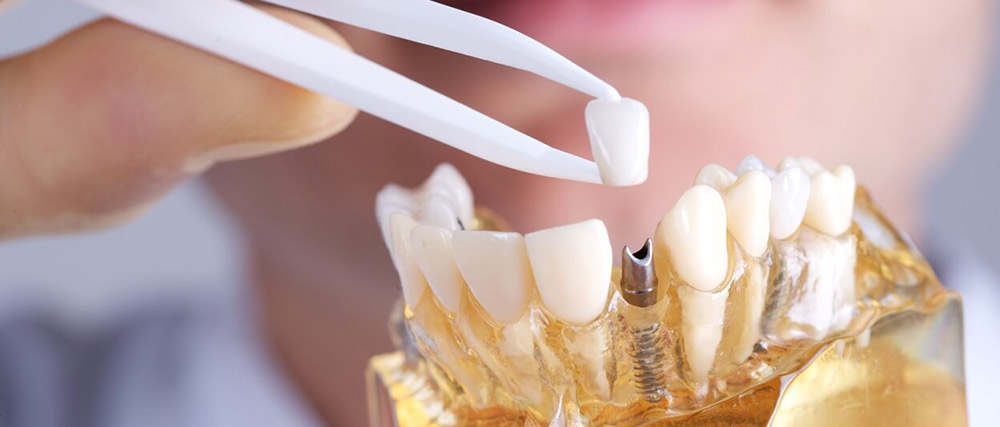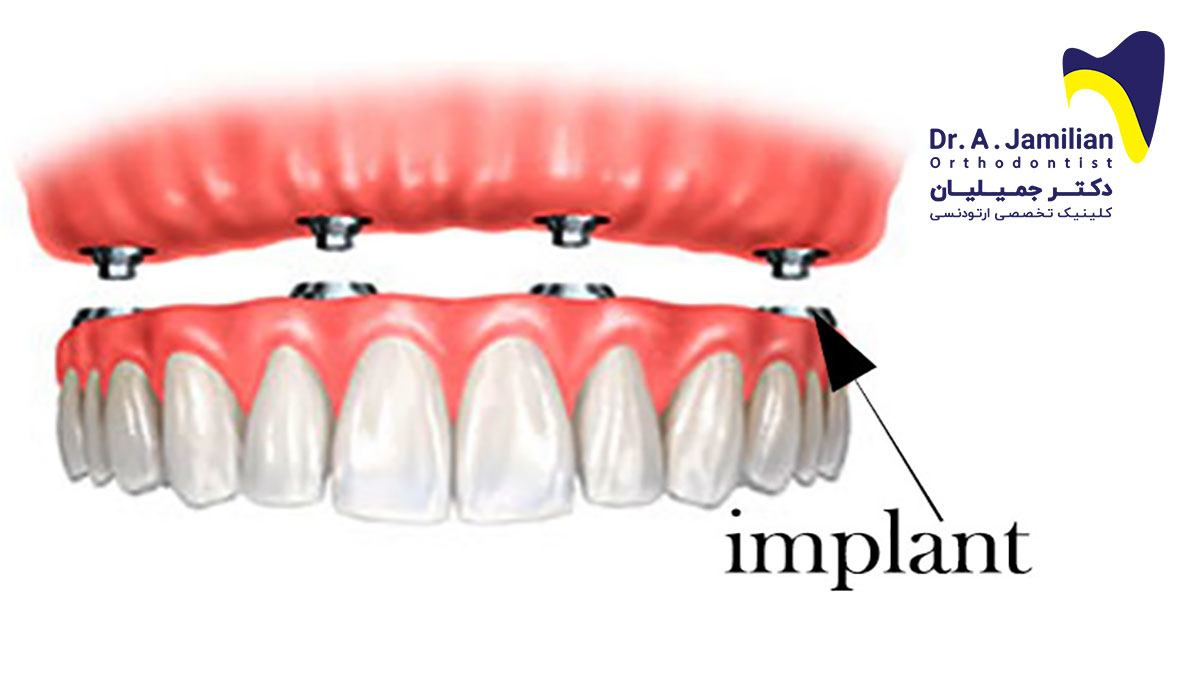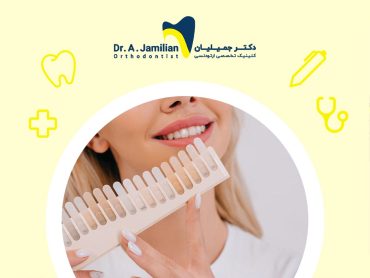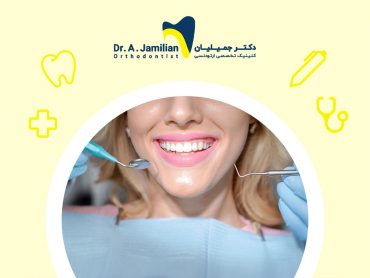If you have lost one or more teeth or have no teeth, you can use dental implants to replace the missing teeth. Dental implant is a piece that is inserted as a root of the tooth into the jawbone and the crown is reconstructed on it.
One of the advantages of dental implant is the lack of need for shaving the adjacent teeth, and therefore, it causes no damages to other teeth. Dental Implants are known as the best solution for replacing missing teeth, since they look completely natural and have no difference from natural teeth and the patient feels completely comfortable when talking and eating.

What are dental implants made of?
Dental implants are usually made of different metals and ceramics with a structure similar to bones, which is compatible with body tissues. Dental Implants are currently made of titanium metal.
How long a dental implant surgery takes?
This time will vary depending on different factors. The recovery time after surgery also depends on the restoration time of the individual’s tissues, however, with the advance of technology, this time has significantly reduced. On average, tissue healing and bone formation take about 2 to 3 months, after which the process of making the prosthesis (the crown) can be started.
What is the success rate of dental implants?
The success rate of dental implants depends on different factors, which vary in different patients. This rate is even different in maxillary and mandibular dental implants. On average, the success rate of dental implants has been reported as 95%.
How to take care of dental implants?
Your body’s health is critical to the success of the dental implant. Lack of oral and dental hygiene is considered as a major cause of dental implant loss. The use of dental floss and brushing at least twice a day are very important. Your dentist will teach you how to properly take care of the dental implant. In order to sure of the health of your gums, visit your dentist at least 4 times a year.
In short, dental implants are used in the following cases:
- Replacing one or several teeth without involvement of adjacent teeth.
- Dental Implants can be used as a bridge base at the end of dental arches, so you don’t have to use removable dentures.
- In cases that whole teeth are missing or large of number of dental implants cannot be used, dental implants can be used as the base for full dentures by placing implants to keep your full denture from moving in your mouth and to make you feel more comfortable.
- The advantages of using dental implants over moveable or fixed dentures (bridge)
- At any angle you look at this, the use of dental implants is the best choice for replacing your missing teeth.
- Cosmetics: The dental implant will look exactly like your tooth, and since it is fixed in your jawbone, it prevents bone and gum erosion, which is considered as one of the complications of the previous methods (denture or bridge). Anyway, no one will notice that you have a replacement tooth.
- Preserving the structure of adjacent teeth: in this method, the adjacent teeth are not shaved and will not develop further caries.
- Self-confidence: Using dental implants will certainly make you feel better about yourself, your laughing, and your talking.
- Reliability: the success rate of dental implants is very high and they are the best choice for replacing your missing tooth. Despite past false claims in this regard, the success rate of dental implants is much higher than other tooth-replacement methods, and since the dental implant fixture is made of pure titanium, there will be no rejection of the dental implant.

Are there any complications after having a dental implant?
Since the dental implant fixture is made of pure titanium, there will be no transplant rejection, however, if the preoperative evaluation, which includes the following, is not carefully performed, the success rate may reduce.
- Infectious diseases that weaken the immune system.
- Uncontrolled diabetes
- Being a smoker
- Inadequate bone mass (in these cases, bone grafting can be done first, then dental implant therapy can be started)
- Periodontal and gum diseases (in these cases, the gum disease should be treated first)
Dental Implant radiography, Objectives of radiography
The objective of radiography is to obtain necessary information about the bone quantity, quality and angle, the relationship between the anatomic structures and the dental implant, and the presence of possible lesions in the surgical sites. The phase two is done during the surgery (surgical and interventional dental implant imaging). This is performed to evaluate the surgical sites during the dental implant placement and right after it. The phase three is done after prosthetic treatment (post-prosthetic implant imaging).
The steps of dental implantation:
Dental Implant surgery by two-stage procedure method
This method requires two surgical procedures:
- First surgical procedure: the dental implant fixture is placed into the bone and completely covered by a mucoperiosteal flap, which is previously dental implanted. In the general term, in the first step, the dental implant is buried underneath the soft tissue.
- Second surgical procedure: in this step, by performing a flap cover, we again remove the cover screw that was initially locked on the fixture and covered by a flap, and then, we place the healing abutment and stitch the flap around it.
The advantage of this method is that the bone healing process takes place without the presence of any forces on the dental implant fixture until the restoration process is carried out.

Dental Implant surgery by single-stage procedure method
This method only requires one surgical procedure.
Similar to the two-stage procedure method, pulling the flap over provides a sufficient view and direct access to the bone. In this method, the permucosal extension element (PME) is placed slightly above the bone crest.
Advantages:
- Maturation of soft tissue at the same time with hard tissue
- No need for second-stage surgery
Dental Implant surgery by direct single-stage method (flapless procedure)
In this method, the soft tissue of crestal bone is not pulled over, but instead, cylinders of keratinized tissue in the size of the diameter of dental implant crest module are removed from the crestal bone, so no stitches are required in this method. However, one of the main disadvantages of this method is the surgeon’s inability to estimate bone mass before osteotomy or during dental implant placement. So it seems obvious that the surgeon is only allowed to use this procedure when the patient has a bone width greater than 8 mm and enough keratinized gingiva.
Summary and overview of dental implant surgery
dental implant surgery can be performed under local anesthesia or anesthetic nerve block, and general anesthesia is required in extensive dental implant surgeries. Before the surgery, the surface of the skin around the patient’s mouth and lips must be disinfected by betadine, and the patient should wash his/her mouth with chlorhexidine mouthwash for 2 minutes. The use of anti-preoperative anxiety is mandatory for patients with severe anxiety, and Benzodiazepine 5mg can be administered the night before surgery and one hour before it. Also, in patients who need antibiotic prophylaxis, antibiotic prophylaxis should be carried out before dental implant surgeries and according to the standard protocol.
The level of pain in dental implants
Since dental implant surgery is carried out under local anesthesia, the patients will have no pain during the surgery. However, after the surgery depending on the duration of the dental implant surgery and the patient’s bone quality and tissue response, some pain and swelling are expected, which can be minimized by administration of medication before and after the surgery.
The cost of having a dental implant:
In this regard, you should consult with your dentist. In many cases, this amount will not be much different from the cost of traditional treatment methods.
Frequent Questions About Dental Implants
1-Can the dental implant be placed the same day as tooth extraction?
Yes, but this decision depends on various factors, such as the condition of gums, the presence of cyst or infection in the extracted tooth, infection at the area, the remained bone amount, and so on. The specialist is the best person for the final decision.
2-How long does dental implant treatment take?
This depends on the patient conditions, implantation area, the remained bone quality and amount, and the patient systemic conditions, but it takes at least three months. If a reconstruction surgery is performed, for example sinus lift, this will take 5 months in the case of simultaneous implantation or 8 months in the case of stepwise implantation.
3-What is dental implant without surgery?
The basis of implantation is surgery in which a small incision is made to reach the bone. However, there is a method with no need for incision and the dental implant is placed through pushing aside the soft tissue and punching the gums. This method, with its advantages and disadvantages, currently has an advertising aspect.
4-Is there an age restriction for dental implants?
People whose jaws are fully grown can get dental implant. In general, dental implants can be placed in all individuals over 18 years.
5-Is a dental implant prone to decay or failure?
No, dental implants are made of metal and do not decay. However, great importance should be given to their health and care. Otherwise, poor oral hygiene may result in gingivitis and bone resorption and infection, after which they can loosen and lost.



